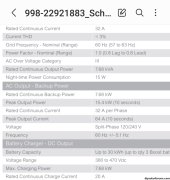400bird
Solar Wizard
The XW mounting bracket has holes at 16" on center for mounting on a standard wall. It also has other mounting holes, it might bolt right up to the studs.
I have a cement board(1/4 inch) in front. I have put a eg4 6k (70 lbs) without issues. I am thinking 120 lbs shouldn't be problem across 2 studs. Plywood/3 studs -- interesting..I would recommend 3/4" plywood that can be secured to at least 3 studs and mount the inverter to that. Drywall would be easily crushed by direct contact due to the weight of the XW.
88lbs, full 7.6kw output on one leg. I don't know how to tell if this is still a low frequency inverter, and if it is how they made it lighter with higher output. Less caps needed with LFP batteries maybe.from Schneider rep: new inverter specs attached..not sure about pricing but looks like it only works with the their batteries (SOC)
from Schneider rep: new inverter specs attached..not sure about pricing but looks like it only works with the their batteries (SOC)
Seems worse than the XW profrom Schneider rep: new inverter specs attached..not sure about pricing but looks like it only works with the their batteries (SOC)
I'm reserving judgement.Seems worse than the XW pro
You may be better off starting your own thread for this.If you wanted to run two inverters with solar panels and diy batteries with grid power as backup for when there is no sun and dead batteries plus a generator to charge batteries when needed which system do you go with, I see DC coupling and AC coupling but the diagrams are not showing the configuration described. Shows AC coupling with no solar panels and shows DC with no grid power tied in.
You may be better off starting your own thread for this.
As for the diagrams, in an AC Coupled scenario, it shows an inverter on the other side of the "AC Out" panel. The idea is, you already have existing solar panels and AC inverter (micro or string inverters, doesn't matter) and thus, you wouldn't be attaching the panels directly up to any schneider gear. Be aware, AC Coupling only, leaves you vulnerable to the dark start problem. So most people put at least a small string of panels for DC coupling.
As for the DC Coupling image showing no grid input, thats likely an oversight. That exactly how I have mine setup, and works perfectly.
You'll probably get mixed opinions, but i'd say.. if you don't already have an existing solar setup, you'd likely want the DC coupled setup.Okay, so the dual inverter dc coupling kit signature solar sells is what I would need for my scenario then.
You'll probably get mixed opinions, but i'd say.. if you don't already have an existing solar setup, you'd likely want the DC coupled setup.
If you wanted to run two inverters with solar panels and diy batteries with grid power as backup for when there is no sun and dead batteries plus a generator to charge batteries when needed which system do you go with, I see DC coupling and AC coupling but the diagrams are not showing the configuration described. Shows AC coupling with no solar panels and shows DC with no grid power tied in.
It does show double surge (15.4kW) but only for 10 seconds, not sure how that compares to the eg4 18k PV.It looks like a slight bump up from the XW Pro, but there's no mention of the extended overload (8.5kW for 30 minutes). That, plus the lower weight, and the much higher efficiency leads me to believe it's a HF inverter.



